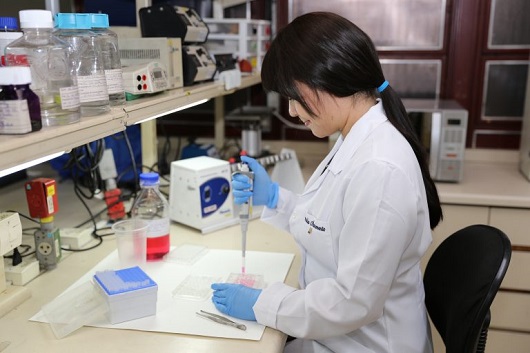Study reveals that cells can be reprogrammed to fight breast cancer
02/05/2023
Fiocruz Minas
Treatments that stimulate the immune system in order to fight cancer have been the focus of scientific studies worldwide. At Fiocruz Minas, a team of researchers has shown that it is possible to prevent the growth of malignant breast tumors by altering the profile of one of the body's defense cell types, macrophages, using iron oxide nanoparticles. The study was recently published in the International Journal of Pharmaceutics.
A team of researchers showed that it is possible to prevent the growth of malignant breast tumors (photo: Fiocruz Minas)
According to the researchers, about 50 percent of the tumor mass consists of macrophages; therefore, these cells' activities directly influence the prognosis of cancer. There are two main types of macrophages: M2, with more anti-inflammatory characteristics, generally related to higher tumor permissiveness; and M1, which is pro-inflammatory and more effective in limiting tumor progression. Thus, the proposal of the researchers was to reprogram the profile of M2 macrophages in the tumor environment, transforming them into M1, in order to inhibit tumor development.
“Through a broad review of the literature on the subject, we saw that iron oxide nanoparticles had the potential to act in reprogramming the macrophage phenotype. So, the idea was to transform M2 into M1, through local treatment, performed directly on the tumor, which allowed greater control as to systemic interventions”, explains the post-doctoral student in the Cellular and Molecular Immunology group, Camila Sales Nascimento, who was in charge of the project.
The iron oxide nanoparticles used in the study were produced in the laboratories at Fiocruz Minas, through a partnership with the Physics Department of the Federal University of Pernambuco, which originally developed the magnetic compound. Nanoparticles are biocompatible, meaning they have low toxicity to healthy cells, as well as low cost and fast synthesis, which facilitates scaling production.
Methodology
To reach their results, the researchers performed three experiments: Two-dimensional (2D) In vitro; in vivo, using laboratory mice; and three-dimensional (3D) in vitro. In the first experiment, the scientists used a special artificial system to put breast tumor cells in contact with the macrophages. After incubating the two cells, it was verified that the tumor cells multiplied. Later, the team introduced the nanoparticles and found that the tumor cells died.
With these results, the researchers moved on to the second experiment, performed on mice. Tumor cells and the nanoparticles were injected into the animals, leaving them under observation for 21 days. At the end of this period, the team found a nearly 50 percent reduction in the tumor mass of the mice exposed to the nanoparticle compared to animals that did not receive the treatment.
The third experiment, the three-dimensional multicellular model, simulated the tumor microenvironment by making it possible to put in contact, besides the tumor cells and the macrophages, other cells from the human organism. Once again results were confirmed, with the transformation of M2 to M1 occurring via the nanoparticles. To carry out this stage, the post-doctoral student spent a period at the University of Porto, in Portugal, which had already performed this type of test. Now, the technique is being implemented at Fiocruz Minas.
For the leader of the Cellular and Molecular Immunology group and project coordinator, Carlos Eduardo Calzavara, the results open up possibilities for new research that, in the future, may allow the emergence of complementary strategies for the treatment of breast cancer. “The study is a starting point. The new research focused on pharmacodynamics and pharmacokinetics is still needed to assess a number of relevant issues, such as physiological effects, mechanisms of action, side effects, drug absorption time, and biodistribution in the body, among other aspects. But we already have the proof of concept, which is very important”, highlights the coordinator.
Calzavara also points out that the project's success is the result of the efforts of the post-doctoral student, who worked on the subject for four years, but also due to a collective effort, which had the collaboration of many people from Fiocruz and, also, from other institutions. “We partnered with the Physics Department of the Federal University of Pernambuco, through Professor Celso Melo, Bruno Sarmento; from the Institute for Research and Innovation in Health at the University of Porto, and several people from our research group and other areas of the institution, in particular, Érica Alves and Anna Lage. It is this teamwork that allowed for such a successful study, which we hope can have new developments”, he says.




